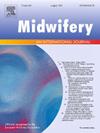Patterns of physical activity, sedentary behavior, and sleep across pregnancy before and during two COVID pandemic years
IF 2.6
3区 医学
Q1 NURSING
引用次数: 0
Abstract
Background
Physical activity is recommended during pregnancy, and high sedentary behavior and poor sleep may increase the risk of pregnancy complications. Activity patterns and sleep were negatively impacted by the COVID pandemic in many segments of the population, but the impact of the pandemic on pregnant people is understudied. We aimed to compare patterns of physical activity, sedentary time, and sleep during pregnancy between a pre-COVID and a COVID-era cohort.
Methods
Physical activity, sedentary time, and sleep in each trimester of pregnancy were compared between two parallel prospective observational cohorts using identical collection methods. Pre-COVID participants (n=111) were recruited in 2017–2019 and COVID-era participants (n=117) from 2021–2023. Physical activity and sedentary time were measured using the activPAL3 micro accelerometer, and sleep duration was self-reported. Between-cohort comparisons were conducted using linear regression for each behavior in each trimester. Within-COVID-era cohort linear regression analyses assessed whether activity patterns differed as pandemic-era restrictions were eased.
Results
Participant demographics were similar between cohorts except for self-reported income. Adjusted mean moderate-to-vigorous physical activity was 57–77 min/week higher in each trimester in pre-COVID compared to COVID-era participants (p<0.001); adjusted mean sedentary time was 0.77–1.13 hours/day lower in each trimester (p<0.01) and sleep duration was 0.8 hours/day lower in the third trimester in the pre-COVID compared to COVID-era cohort (p<0.05). Within the COVID-era cohort, no significant within-trimester differences were detected across the pandemic years.
Conclusions
Pregnant participants during the COVID pandemic were less active and more sedentary than their pre-pandemic counterparts, and this trend was still detected years after the pandemic began. A more sedentary lifestyle during pregnancy may have health implications, and prenatal care providers should help pregnant people identify strategies to adopt an active lifestyle in the context of pandemic-era barriers.
在两个COVID大流行年份之前和期间怀孕期间的身体活动、久坐行为和睡眠模式。
背景:建议怀孕期间进行体育锻炼,久坐不动和睡眠不足可能会增加妊娠并发症的风险。COVID大流行对许多人群的活动模式和睡眠产生了负面影响,但大流行对孕妇的影响尚未得到充分研究。我们的目的是比较covid前和covid时代队列之间怀孕期间的身体活动、久坐时间和睡眠模式。方法:采用相同的收集方法,在两个平行前瞻性观察队列中比较每个妊娠期的身体活动、久坐时间和睡眠。2017-2019年招募了Pre-COVID参与者(n=111), 2021-2023年招募了covid时代参与者(n=117)。使用activPAL3微加速度计测量身体活动和久坐时间,并自我报告睡眠时间。使用线性回归对每个妊娠期的每种行为进行队列间比较。covid - 19时期队列线性回归分析评估了大流行时期限制放松后活动模式是否有所不同。结果:除了自我报告的收入外,参与者的人口统计数据在队列之间相似。与COVID时代的参与者相比,COVID前每个月的调整后平均中高强度体力活动增加了57-77分钟/周(结论:与大流行前的孕妇相比,COVID大流行期间的孕妇活动量更少,久坐时间更长,并且在大流行开始数年后仍然可以发现这一趋势。怀孕期间久坐不动的生活方式可能会对健康产生影响,产前保健提供者应帮助孕妇确定在大流行时期采取积极生活方式的策略。
本文章由计算机程序翻译,如有差异,请以英文原文为准。
求助全文
约1分钟内获得全文
求助全文
来源期刊

Midwifery
医学-护理
CiteScore
4.50
自引率
7.40%
发文量
221
审稿时长
13.4 weeks
期刊介绍:
Midwifery publishes the latest peer reviewed international research to inform the safety, quality, outcomes and experiences of pregnancy, birth and maternity care for childbearing women, their babies and families. The journal’s publications support midwives and maternity care providers to explore and develop their knowledge, skills and attitudes informed by best available evidence.
Midwifery provides an international, interdisciplinary forum for the publication, dissemination and discussion of advances in evidence, controversies and current research, and promotes continuing education through publication of systematic and other scholarly reviews and updates. Midwifery articles cover the cultural, clinical, psycho-social, sociological, epidemiological, education, managerial, workforce, organizational and technological areas of practice in preconception, maternal and infant care.
The journal welcomes the highest quality scholarly research that employs rigorous methodology. Midwifery is a leading international journal in midwifery and maternal health with a current impact factor of 1.861 (© Thomson Reuters Journal Citation Reports 2016) and employs a double-blind peer review process.
 求助内容:
求助内容: 应助结果提醒方式:
应助结果提醒方式:


